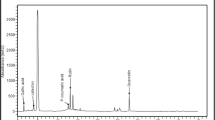Abstract
In this study, we present antioxidant and antimicrobial activity of isolated lignans freed of other bioactive compounds in comparison with dominant phenolic acids. The combinations of screw pressing, solvent extractions, acid-catalysed hydrolysis and flash chromatography were used to describe and isolate linseed phenolic compounds. Secoisolariciresinol, ferulic, p-coumaric and caffeic acids were the most abundant ones while salicylic, gentisic, dihydro-p-coumaric, phenylacetic, vanillic, p-hydroxybenzoic and β-resorcylic acids were the minor secondary metabolites. Anhydrosecoisolariciresinol (ANHSECO) and levulinic acid were an artefacts formed during exhaustive hydrolysis. The effective concentration (EC50), antiradical power (1/EC50), stoichiometry (2·EC50) values and second order rate constants k 2 were determined to classify antioxidants according to reaction kinetics as slow (p-coumaric acid derivatives), medium (ferulic acid derivatives, secoisolariciresinol and ANHSECO; k 2 ranges from 1.85 to 2.29 μmol−1 dm3 s−1) and fast (caffeic acid derivatives; k 2 = 6.91 μmol−1 dm3 s−1) ones. Rancimat method was simulating lipid peroxidation and its inhibition. Linseed lignans and phenolic acids could be classified according to protection of unsaturated triacylglycerols in the following order: p-coumaric acid < ANHSECO < methyl p-coumarate < ferulic acid < secoisolariciresinol < methyl ferulate < crude extract < caffeic acid < methyl caffeate. The mechanism and the formation of secoisolariciresinol oxidation products were discovered by mass spectrometry. The effect of crude linseed extract, ANHSECO, caffeic, ferulic and p-coumaric acid on the growth of Gram-negative bacteria, Gram-positive bacteria, yeasts and moulds was also determined.






Similar content being viewed by others
References
Bjelkova M, Genčurová V, Griga M (2011) Ind Crops Prod 33(3):761–774
Shim YY, Gui B, Arnison PG, Wang Y, Reaney MJT (2014) Trends Food Sci Tech 38:5–20.
Stanley DW, Gill TA, deMan JM, Tung MA (1976) Can Inst Food Sci Technol J 9(2):54–60
Mishra K, Ojha H, Chaudhury NK (2012) Food Chem 130(4):1036–1043
Suja KP, Jayalekshmy A, Arumughan C (2004) J Agric Food Chem 52(4):912–915
Goupy P, Dufour C, Loonis M, Dangles O (2003) J Agric Food Chem 51(3):615–622
Charlet S, Bensaddek L, Raynaud S, Gillet F, Mesnard F, Fliniaux M-A (2002) Plant Physiol Biochem 40(3):225–229
Sarajlija H, Čukelj N, Novotni D, Mršić G, Brnčić M, Ćurić D (2012) Czech. J Food Sci 30(1):45–52
Meagher LP, Beecher GL, Flanagan VP, Li BV (1999) J Agric Food Chem 47(8):3173–3180
Smeds AI, Eklund PC, Sjöholm RE, Willför SM, Nishibe S, Deyama T, Holmbom BR (2007) J Agric Food Chem 55(4)1337–1346
Eklund PC, Långvik OK, Wärnå JP, Salmi TO, Willför SM, Sjöholm RE (2005) Org Biolmol Chem 3:3336–3347
Sánchez-Moreno C, Laurrauri JA, Saura-Calixto F (1998) Sci Food Agric 76(2):270–276
Villaño D, Fernández-Pachón MS, Moyá ML, Troncoso AM, García-Parrilla MC (2007) Talanta 71:230–235
Brand-Williams W, Cuvellier ME, Berset C (1995) LWT-Food Sci Technol 28(1):25–30
Merkl R, Hrádková I, Filip V, Šmidrkal J (2010) Czech J Food Sci 28(4):275–279
Popova IE, Hall C, Kubátová A (2009) J Chrom A 1216(2):217–229
Sicilia T, Niemeyer HB, Honig DM, Metzler M (2003) J Agric Food Chem 51(5)1181–1188
Willför SM, Smeds AI, Holmbom BR (2006) J Chrom A 1112(1–2):64–77
Xu L, Davis TA, Porter NA (2009) J Am Chem Soc 131(36):13037–13044
Szydłowska-Czerniak A, Bartkowiak-Broda I, Karlović I, Karlovits G, Szłyk E (2011) Food Chem 127(2):556–563
Xie J, Schaich KM (2014) J Agric Food Chem 62(19):4251–4260
Fuster MD, Lampi AM, Hopia A, Kamal-Eldin A (1998) Lipids 33(7):715–722
Hrádková I, Merkl R, Šmidrkal J, Kyselka J, Filip V (2013) Eur J lipid sci Technol 115:747–755
Kosova M, Hrádková I, Mátlová V, Kadlec D, Šmidrkal J, Filip V (2015) J Clin Pharm Ther 40:436–440
Yuan J-P, Li X, Xu S-P, Wang J-H, Liu X (2008) J Agric Food Chem 56(21):10041–10047
Smith MB, March J (2007) March´s advanced organic chemistry, 6th edn. Wiley, Hoboken, New Jersey, pp 534–535t;/bib>
Craft BD, Kerrihard AL, Amarowicz R, Pegg RB (2012) Compr Rev Food Sci Food Saf 11(2):148–173
Masuda T, Akiyama J, Fujimoto A, Yamauchi S, Maekawa T, Sone Y (2010) Food Chem 123(2):442–450
Meagher LP, Beecher GR, Flanagan VP, Li BW (1999) J Agric Food Chem 47(8):3173–3180
Maillard JY (2002) J Appl Microbiol 92:16S–27S
Välimaa AL, Honkalampi-Hämäläinen U, Pietarinen S, Willför S, Holmbom B, Wright von A (2007) Int J Food Microbiol 115(2):235–243
Acknowledgements
This work was supported by the Ministry of Agriculture of the Czech Republic, National Agency of Agricultural Research, Project No. QJ1510274 in the programme KUS and financial support from specific university research (MSMT No. 20-SVV/2016, MSMT No. 20-SVV/2017). The authors are indebted to Erik Pesek, M.Sc., for the determination of chemical and physical characteristics of linseed oils and the expeller cake.
Author information
Authors and Affiliations
Corresponding author
Ethics declarations
Conflict of interest
The authors have declared no conflict of interest.
Compliance with ethics requirements
This article does not contain any studies with human or animal subjects.
Rights and permissions
About this article
Cite this article
Kyselka, J., Rabiej, D., Dragoun, M. et al. Antioxidant and antimicrobial activity of linseed lignans and phenolic acids. Eur Food Res Technol 243, 1633–1644 (2017). https://doi.org/10.1007/s00217-017-2871-9
Received:
Revised:
Accepted:
Published:
Issue Date:
DOI: https://doi.org/10.1007/s00217-017-2871-9




